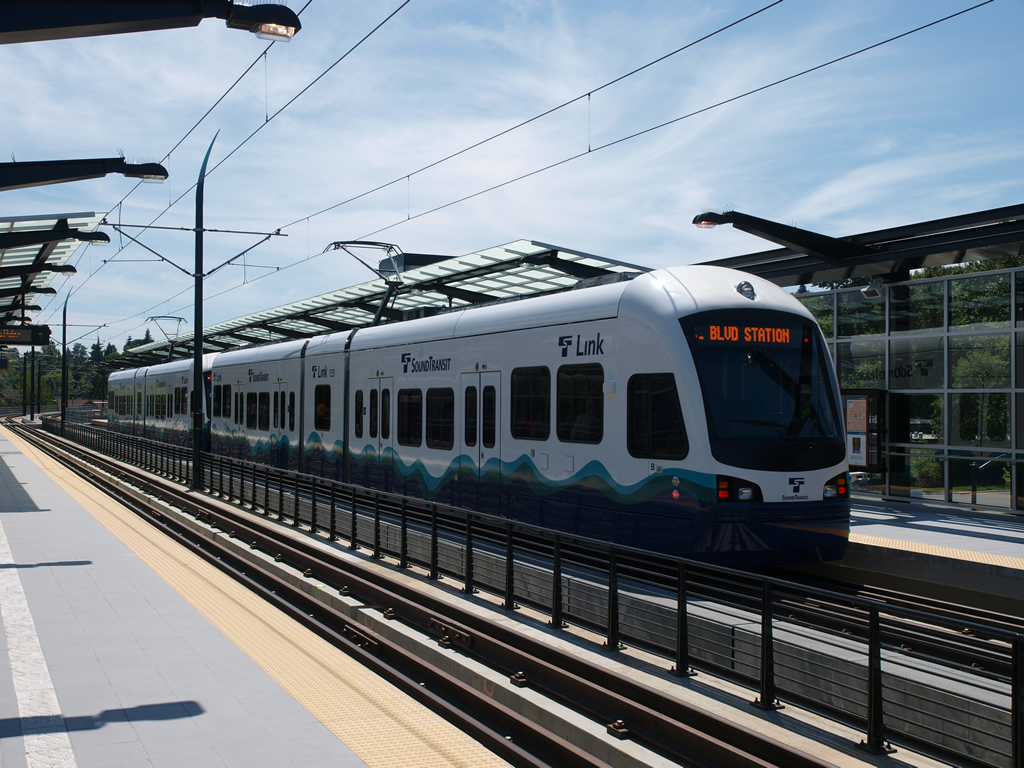Happy news to share this afternoon: Sound Transit revealed today that demand for its express bus, commuter rail, and light rail services is booming, while also announcing that it has restored funding for engineering work on future light rail extensions to Federal Way and downtown Redmond, where NPI is headquartered.
Sound Transit, as most Cascadia Advocate readers probably know, is the multi-county regional transit authority that voters created in 1996 to build a high capacity transit network for the cities of Seattle, Tacoma, Everett, Bellevue, and their suburbs. ST’s early years were rocky, but today, it is a model public agency, delivering projects on time (or even ahead of schedule) and under budget.
Sound Transit’s services just continue to grow in popularity (as we have always believed that they would.) The latest ridership figures bear this out:
Sound Transit riders once again set all-time annual records in 2015 for boardings on commuter trains, buses and light rail in central Puget Sound. Sound Transit had an estimated 34.9 million total boardings last year, a 6 percent increase over 2014. Average weekday boardings were 116,839 in 2015.
And this year, with three new light rail stations opening (including two less than a month from now!) we will certainly be seeing another ridership increase.
“We continue to set new records for ridership by providing fast, reliable alternatives to driving,” said Sound Transit Board Chair and King County Executive Dow Constantine, touting the figures in a news release. “More people than ever in our region are choosing transit to get to their destination.”
Here’s the breakdown by mode:
Average weekday boardings
- Sounder commuter rail: 14,600 — a 15 percent increase from 2014
- Link light rail: 35,573 — an 8 percent increase from 2014
- ST Express regional buses: 62,981 — a 3 percent increase from 2014
Annual boardings
- Sounder commuter rail: 3.8 million, 13 percent increase from 2014
- Link light rail: 11.7 million, 7 percent increase from 2014
- ST Express regional buses: 18.3 million, 4 percent increase from 2014
As Link continues to expand north (to Lynnwood), south (to Federal Way), and east (to Redmond), ridership will climb dramatically. It won’t be much longer before light rail becomes the mode with the highest overall ridership.
Of course, there’s room for the Express bus network to grow as well. As the rail spine grows longer, Sound Transit ought to be able to increase the frequency and quality of service to communities that are currently underserved.
Getting that rail spine built out as quickly as possible is a top priority for the Sound Transit Board. That’s why, today, the Board voted to authorize staff to spend the money to move forward with the design for Link extensions to Federal Way and downtown Redmond. This work was supposed to be part of the 2008 Sound Transit 2 package, but it was put on hold after the Great Recession wiped out a whopping $4.2 billion from projected sales tax revenue.
The economy has improved, and sales tax revenue has rebounded somewhat above what was forecasted. Consequently, Sound Transit now has the resources to do this vitally important engineering work. It’s very good news.
“Extending light rail to Federal Way and downtown Redmond has remained a top priority for Sound Transit,” said Constantine. “Restoring funding for the next phase of project design brings us another step closer to connecting more people to our growing regional mass transit system.”
Funding still doesn’t exist to actually build light rail to Federal Way and downtown Redmond, but these projects are both a lock for inclusion in the forthcoming Sound Transit 3 package that the Board is expected to send to voters this year.
Tim Eyman, Washington’s infamous purveyor of destructive initiatives, is presently attempting to qualify an initiative to the ballot that would wipe out one of the funding sources for Sound Transit 3. This measure, I‑1421, would also repeal state-level funding for Amtrak Cascades and freight mobility projects.
NPI is already working to organize opposition to Eyman’s I‑1421 so that we stand the best chance possible of defeating it should it qualify for the ballot.


What a pleasant surprise. I guess if sales tax money goes away it can also come back…